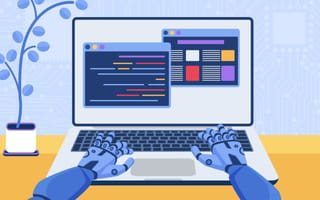Centuries before coding became a popular career path, engineering, in its purest form, didn’t just dominate one single industry — it reigned over the entire world.
Ancient Egyptians leveraged intricate engineering to bring its famous pyramids to life more than 4,000 years ago, while Ancient Romans employed their own engineering acumen to construct the Colosseum in 72 A.D. In the centuries following, engineering became the driving force behind global progress, fueling the Industrial Revolution and, more recently, the digital age.
Engineering has shaped the world we live in, and while these aforementioned time periods are distinct, each one is united by a common thread: the need to overcome a challenge.
That’s where engineering design comes in. Modern-day software engineers keep this concept at the forefront of the work they accomplish every day: What problem is this solution intended to solve?
Considering companies are expected to deliver impactful solutions faster than ever before, it begs the question: Why not add AI into the mix to make the process even more efficient?
Many companies have decided to incorporate AI into the engineering design process for various reasons, including the need for speed. This is the case for Aleena Khan and her peers at Personio, where AI has helped them overcome challenges much more quickly.
According to Khan, AI offers so many benefits that she and her teammates spend a lot of time simply narrowing down how they and other teams can use it. And as a result, she’s excited for the company’s future.
“AI-powered HR software has so much potential to make Personio super efficient,” Khan said.
Incorporating AI in engineering design is also driving growth in digital therapeutics. At Click Therapeutics, Research and Development Prototyping Manager Jesse Mursky-Fuller and others on his team use AI to shorten user feedback loops, identify potential business opportunities and more, all of which makes it easier for the company to help people overcome mental and physical health challenges.
“Needless to say, AI has become a powerful tool that we are using more and more in our engineering problem-solving processes each day,” Mursky-Fuller said.
Below, Khan and Mursky-Fuller share more about how their teams are using AI in engineering design, the challenges they’ve overcome along the way and their enthusiasm for the future of AI.
Personio’s HR software enables businesses to automate processes and workflows, garner insights from data, foster employee engagement and more.
How does your team use AI in the engineering design process, and what benefits have you observed?
In my team at Personio, we use AI to spin up how to quickly solve problems, especially if it falls outside of the scope of development. Of course, engineering problems are my job to think about, but for simple things like finding the phrasing for searching, summarizing data or compiling lists, I can easily research without having to bug anyone else. This means AI lets me stick to what I love doing the most. Using it has made developing the platform for AI at Personio a super engaging experience, helps me save time and lets me build a lot faster.
What challenges have you encountered when implementing AI technologies in engineering design, and how have you addressed these issues?
The use case for AI and the needs of companies that use HR software is incredibly broad. A lot of our design process has been iterating and unlocking the full depth of what our AI product can do, and exploring how we can let other teams leverage this AI for their own use cases. It can be challenging to whittle down the sheer amount of ideas into actual use. AI can do so much — How do we make use of that while making it effective and accurate? A lot of it involves building trust, planning and building effectively.
“A lot of our design process has been iterating and unlocking the full depth of what our AI product can do, and exploring how we can let other teams leverage this AI for their own use cases.”
What excites you most about your team’s future when it comes to leveraging AI in innovative ways?
We have so much to look forward to in the AI space. In a way, a lot of my own use inspires what we are building; if using AI helps me save time and build more effectively, then I keep that vision in mind for people that use Personio’s AI. We might be building AI, but the focus has always been on unlocking the power of people.
Click Therapeutics develops digital treatments that address a wide range of disorders and conditions, from major depressive disorder to obesity.
How does your team use AI in the engineering design process, and what benefits have you observed as a result?
At Click, we are using AI to help us quickly understand problem spaces, reduce delivery times and shorten user feedback loops. We designed a user research prototype in a specific way so that an engineer using AI could rapidly respond to user feedback, thus speeding up our validation process.
“At Click, we are using AI to help us quickly understand problem spaces, reduce delivery times and shorten user feedback loops.”
In addition, we leverage machine learning to help us more quickly identify potential business opportunities and validate hypotheses after testing. Needless to say, AI has become a powerful tool that we are using more and more in our engineering problem-solving processes each day.
What challenges have you encountered when implementing AI technologies in engineering design, and how have you addressed these issues?
AI continues to progress exponentially, but there are still significant and, sometimes, unknown limitations to the use of AI in engineering problem-solving. The rapid evolution of these capabilities presents opportunities to revisit and enhance previous applications, potentially leading to even more groundbreaking results. While staying current requires ongoing effort, the pace of advancement ensures that exploration and re-validation are consistently rewarding. We’ve also addressed these challenges by providing internal workshops, helping our teams understand which problems AI is best used for, what to expect from using it and how to maximize the likelihood of meeting those expectations when using it.
What excites you most about your team’s future when it comes to leveraging AI in innovative ways?
At Click, we develop digital therapeutics, which means we have a unique opportunity to think creatively about how to deploy AI in our processes to provide genuine therapeutic benefits for mental and physical health. Our teams are often asking themselves, “Does using AI in our processes enable people to receive therapy in a new way?” So, I’m excited about how leveraging AI not only helps us support people in need but allows us to reimagine our engineering problem-solving processes, enabling all team members to process learnings faster and ultimately apply creativity to drive our products in new directions. It’s not often that engineers get to redesign the way we work and flex new skills, but that’s exactly what we’re doing with AI.









